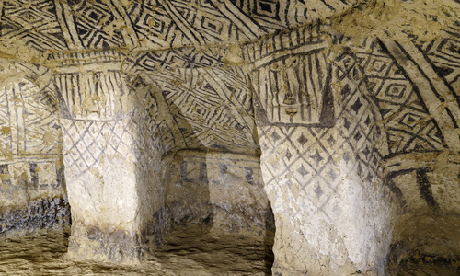
Thomas Rees hikes the National Archaeological Park of Tierradentro in search of rock-hewn burial chambers and pre-Hispanic cave art
We sat under the scant shade of a guava tree, listening to the hum of insects in the long grass and watching a late afternoon shower soften the outlines of the statues. Vultures with ragged wings hung in the valley below and circled the tops of the hills as groves of banana trees tumbled down the slopes ahead of us breaking the lines of the coffee terraces which striped the landscape. For a while Juan was silent, then conversation turned back to the tombs, to the columns carved with ancient faces and the rock-hewn walls with their riddle of geometric patterns.
The seductive charm of colonial Cartagena and the lure of the Caribbean means that few travellers make it to the west of Colombia. Fewer still venture into the hills and valleys of Cauca, to the village of San Andrés de Pisimbalá and the National Archaeological Park of Tierradentro.
It's unsurprising. Though many are now being paved, most of the surrounding roads are deeply rutted and disagreeable. Come via the town of Popayán, en route from the Ecuadorian border, and you'll spend several hours lurching along dirt tracks through a landscape of mist-shrouded Andean moorland in a hand-me-down American school bus.
But don't be dissuaded. It would be worth it for the rural tranquility and the scenery alone. It's all the more worth it for the sense of adventure and, once you learn that the hills surrounding San Andrés are riddled with tombs carved into the rock and decorated with pre-Columbian cave paintings, the decision becomes an easy one.
Now a UNESCO World Heritage Site, these scattered hypogea range from claustrophobic earthen hollows to elaborate burial chambers set nine meters deep in the volcanic bedrock and reached by spiralling staircases. Designed to house the remains of Tierradentro's pre-Columbian elite, they offer all manner of intriguing insights into a north Andean culture that flourished between the 6th and the 10th centuries.
Descend the steps of the tombs at Alto de San Andrés or Alto de Segovia, wait for the lamps to flicker into life, and you'll be greeted by swirls of mineral pigment, riotous zigzag patterns and delicately painted animals picked out in red, yellow and black.
In some you'll find human figures, inquisitive faces and birds. At Alto del Aguacate, the beam of my torch illuminated the shapes of salamanders, agents of the underworld, separated from a celestial sphere that hung with coloured moons by a black line representing the earth. Just as fascinating were a series of shallow pits dug into the floor. A trip to the site's museum later that morning confirmed that they were for the servants of the deceased. Their sunken graves were indicative of lower status and evidence of a hierarchy that continued into the afterlife.
At El Tablón a number of monolithic stone statues depicting broad-shouldered warriors, priests and women in turbans, are also on display. It was here that I met Juan, a barrel chested park ranger with a thick black moustache. He spoke wistfully of the 1980s when many of the painted tombs were first exhumed and of the intensity of the colours. “There are hundreds more,” he said, “you can find them all over these hills”. I was due to leave for Bogotá the next day but my plans were fast beginning to change. The rest of Colombia could wait.
The logistics:
Tierradentro can be reached by bus or in one of the pickup trucks used as collective taxis (colectivos) throughout the region. They run sporadically throughout the day and drop you at a crossroads a short walk from the museum or further up the hill in San Andrés itself. The journey from Popayán takes between 4 and 6 hours. La Plata (en route to San Agustín) is 4-5 hours to the south east.
The tombs are scattered throughout the hills and must be reached by walking or on horseback. Maps and information are available at the Casa de Cultura in San Andrés and at the museum where you can hire horses for around US$2 an hour.
Though it's possible to visit all of the sites in the valley in a single day if you start early, it's best not to rush. The climb to Alto del Aguacate, in particular, is steep and requires a good level of fitness. At the time of writing a day ticket valid for the museum and all of the surrounding tombs cost US$8.
The larger tombs are lit and looked after by park rangers, many of whom are extremely knowledgeable about the area and its history. A torch is recommended, however. Ask permission before taking photos and don't, under any circumstances, use flash.
There are a number of small restaurants and guest houses in San Andrés and along the road to the museum. Hospedaje Luzerna, run by doting octogenarian couple Don Secundario and his wife Carmelita, comes highly recommended.
The area is fantastic for birdwatching and there are many spectacular hiking trails connecting nearby villages. It's a great place for an extended stay.